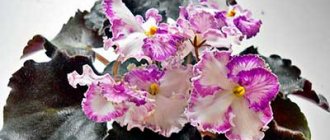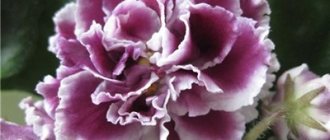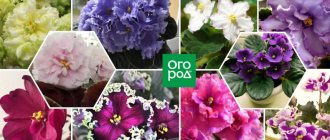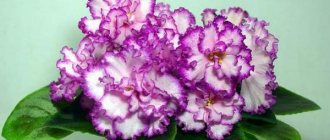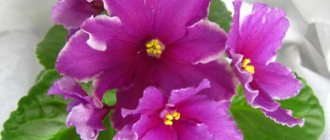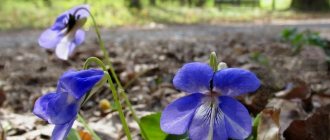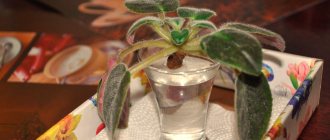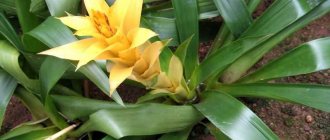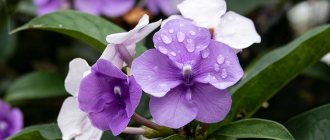Violet N e ss' O range P e koe (N e ss O range P and kou) D. Ness
Semidouble-double coral large pansy. Variegated dark green, pink and cream, scalloped/red back. Large
Semi-double-double coral large pansies. Variegated dark green, pink and cream scalloped foliage with a red underside. Large standard.
Properties
Name
- Original: N e ss' O range P e koe
- Transcription: O ranj P and kou
- Translation: “Tea worthy of the Prince of Orange”
Registration
- Selection: D. Ness
- Year:
Socket
- Socket type: standard
Flower
- Flower size, up to: 6 cm
- Flower shape: pansy
- Terry size: semi-double, terry
- Main color: coral
- Color type: plain
- Border: none
- Other features: no
Foliage
- foliage color: dark green
- foliage type: simple
- foliage shape: round
- reverse side of sheet: red
- leaf edge: jagged edge, (festoons - ?)
- variegation: bordering (Tommy Lowe)
Story
Ness' Orange Pekoe is a retro variety that has become a classic. The date of its creation is the end of the last century. The history of the author who created this variety can be found here.
Orange Pekoe is a category of tea leaf, but it has nothing to do with oranges (or the color orange). This is an English copy of the name of the dynasty of the Princes of Orange. The Dutch in the 16th century were the largest suppliers of tea, and the best varieties of tea went to the court. Thus, “orange” is “tea supplied to the court,” “tea worthy of the Prince of Orange.” (Source)
Possible problems during cultivation
The reasons for the deterioration in the appearance of Saintpaulia can be improper care, attack by pests or diseases.
Improper care
Errors in care include excessive watering, non-compliance with light and temperature conditions. Signs that the plant is experiencing discomfort include the appearance of spots on the leaves or their wilting.
Pests and diseases
Usambara violet Ness Crinkle Blue is susceptible to a number of diseases, such as late blight, fusarium, powdery mildew and various rots. The most common parasites of the plant are aphids and cyclamen mites. At the first signs of damage to the flower, the leaves and soil should be treated, and sometimes transplanted into another pot.
Saintpaulias - flowering and unpretentious plants
Saintpaulia Ness crinkle blue is a beautiful variety presented to the world by breeder Don Ness. His name is also given to such species as Uzambara violet orange pekoe, satin rose and many others. If you follow simple rules for care and maintenance, these unpretentious flowers will delight you with beautiful blooms almost all year round.
Peculiarities
Quite large, double or semi-double coral flowers create a beautiful bouquet against the background of an even show variegated rosette. In semi-double flowers, the shape of a simple violet flower is pronounced. The flowers are often double, with 3-5 flowers on strong peduncles. Depending on the conditions, the flowers range from bright coral to coral-fawn. And even on the same rosette, the brightness of flowering can vary. Flowering is frequent and long lasting.
The rosette is smooth and self-forming. The variegation is pink-cream, quite bright on young plants. In conditions of elevated temperatures, variegation can almost completely disappear. But if the rosette is placed in cooler conditions, beautiful brightly colored variegated leaves again appear from the center of the rosette.
The variety loves natural light, but also grows and blooms well on a shelf under artificial light. Propagates well from leaf cuttings and produces a large number of children. Blooms quite early. Blooms profusely and often. This variety is one of the most suitable for beginning collectors.
Violet care basics
The Uzambara violet has firmly established itself as a capricious and very whimsical indoor plant that loves to show a bad character at any opportunity. However, this only applies to those situations where Saintpaulia receives completely incorrect care, which becomes the cause of all the troubles.
For lush flowering and the formation of a beautiful rosette, a violet needs only a long daylight hours, a properly selected pot and soil, adjusted watering and periodic fertilizing. Temperature and humidity play a rather secondary role - although Saintpaulia does not tolerate heat well, it can be compensated for by good air ventilation in the room.
Lighting
Sufficient lighting is a necessary condition for planting buds. Violet needs 10-14 hours of daylight, so in winter it is impossible to do without additional lighting. You can use both fluorescent and LED lamps for this. Most collectors use the second option, which is not only much more economical in terms of energy consumption, but also does not increase the temperature near the plants due to heating.
When choosing lamps for illumination, be sure to pay attention to the temperature of the glow. For Saintpaulias, 4000-6200 K is considered optimal, which is as close as possible to natural daylight.
When growing on windowsills, it is preferable to choose the western or eastern side. On a south-facing window, the scorching rays of the midday sun in the summer heat can cause unsightly burns on the leaves, so if it is not possible to move the violet to another place, be sure to shade it. It is enough to stick reflective film, paper or newspaper on the glass. There is not enough light on the northern window, so the Saintpaulia will have to be illuminated.
Choosing a pot and preparing the substrate
Modern violet does not like the spacious pots in which our grandmothers grew these plants. That is why you should not plant a flower in a “bucket”, but always choose a flowerpot whose diameter is three times smaller than the diameter of the rosette itself.
For standard Saintpaulias, pots with a diameter of 7 cm or 8 cm are considered optimal, in which the root system can develop normally, but does not “go crazy” from a large amount of soil. It is imperative to have drainage holes at the bottom through which excess water will be drained into the pan.
The main thing in the substrate for Saintpaulia is looseness, breathability and lightness. At the same time, the composition of the soil itself varies depending on the method of watering that the collector plans to resort to:
- For top watering, the ratio of peat to perlite is 2:1 or 3:1;
- For wicking, peat and perlite are mixed in a 1:1 ratio.
As protection against fungal diseases and mold, it is recommended to mix crushed activated carbon and sphagnum moss, which is a natural antiseptic, into the substrate. To destroy fungal spores and pests that may be in the peat, the finished soil is heated in the microwave, steamed over a water bath, or spilled with a solution of Fitosporin (the water should be slightly colored).
Watering rules
Violet is a plant sensitive to soil flooding, and the consequences of such an oversight may not show themselves immediately, but only after a few days. Excessive soil moisture in the heat is especially dangerous - in such a situation, Saintpaulias die almost instantly from bacteriosis, which quickly spreads along the trunk and leaves.
The following recommendations will help you avoid basic watering mistakes:
- Use only warm or room temperature water that has been left standing for several days or passed through a reverse osmosis filter;
- Too hard water must be softened by adding ½ tsp. oxalic acid per 5-6 l;
- Moisture should not remain in the pan (for violets on top watering) or contact the roots of the plant for a long time (for wick);
- Be sure to place a drainage layer of foam pieces at the bottom of the pot, which prevents the roots from rotting.
When and how to feed
Fertilizing can be introduced a month after violet transplantation, so that it begins to receive additional nutrition in the form of microelements and other components important for growth and flowering. Fertilizers “Kemira Lux”, “Royal Mix”, as well as other compositions for Saintpaulias and Gesneriaceae are suitable. Professional fertilizers “Peters” also show good results.
It is better to reduce the dosage of fertilizers by 2-3 times recommended on the package, but at the same time feed the violet more often, especially during the flowering period. It must receive sufficient amounts of phosphorus and potassium, which play an important role in the budding process.
Be sure to fertilize the violet in a moist substrate to avoid burns to the root system. It is best to dilute liquid or powder fertilizers in water for irrigation.
As for the temperature regime, it is better to avoid extreme coolness, as well as heat. Violet does not feel well when the temperature rises above +26 degrees, however, even +24 can be critical for it. The permissible lower range is +11-+13 degrees.
Saintpaulia does not like drafts, so do not place it near open windows or a balcony door - unsightly spots will appear on the leaves.
Photo
Violet Ness' Orange Pekoe, D. Ness. Photo by S. Sazykina:
Violet Ness' Orange Pekoe, D. Ness. Photo: Alena Buryakova:
Violet N e ss' O range P e koe, photo by Evgenia Fedoryachenko.
A young starter (photo from the time when the variety first appeared in the collection):
The same outlet after a year and a half:
Ness' Orange Pekoe, D.Ness, photo by T. Lysikova:
First flowering:
Violet Ness' Orange Pekoe, photo by Olga Osipenko:
And this is the first flowering - the flowers were double:
Photo by Olga Osipenko:
Reproduction
What is the name of violet pink, blue, purple and others
Most often, Saintpaulias are propagated by leaf cuttings. Only healthy and not too young leaves should be used.
Procedure:
- The cuttings are placed in water until roots appear.
- Then it must be rooted in a substrate of peat and sand mixed in a 2/1 ratio.
- After 2-3 leaves appear, they are picked into separate pots.
Propagation by leaf cuttings - quick and easy
For large plants, when replanting, the method of dividing the bush is used. Propagation by seeds is a rather labor-intensive and time-consuming process, which is only relevant for obtaining plants of a rare variety.
Attention! To get seeds yourself, you need to carry out artificial pollination of flowers.
Reviews
Tatiana Lysikova. I really like this variety too. I can’t say that the rosette is very large... I have a rosette of this variety growing on a wick and on a rack on the bottom shelf. Feels very good, blooms often, flowers last a long time. In cool conditions, variegation appears better. It propagates well and quickly by cuttings and produces many children.
Evgenia Fedoryachenko. The variety is one of the most beloved in the collection, but there are few photographs, since it is very difficult to convey the true shade of the flowers. Even words cannot describe this unique shade - it is pink, and a little coral, and brick at the end of flowering. The variety is generally not capricious, but, like all variegated leaves, it does not tolerate heat well. To maintain beautiful variegation, it is advisable to comply with three conditions - cool conditions, sufficient lighting and regular replanting.
Olga Osipenko. I really like this variety! It has dense dark green leaves. They lay beautifully in tiles row after row. Round shiny. Dark green with white and pink-cream variegation. And all this in combination with bright pink-salmon pansy flowers. In the first year the flowers were very large and very double. The color in the photographs was amazingly correct. And this is just the perfect socket, in my opinion!
What Saintpaulia Ness crinkle blue looks like
This variety of Saintpaulia stands out due to its external characteristics.
Stunning Saintpaulia Ness crinkle blue
It will be no less interesting to learn about the origin of the variety, as well as about other varieties from this group.
Description
Saintpaulia Ness crinkle blue is a semi-miniature variety. The size of the rosette, flowers and leaves is average. The plant is characterized by long flowering with breaks of 1-2 months.
The leaves are dark green, with a serrated edge and a sharp tip. The flowers are double, the petals are arranged in several layers. The color of the inflorescences is blue with a thin white rim around the edge. During flowering, the flower stalks bend under the weight of the inflorescences, lie on the rosette and almost completely cover it.
History of origin and species
Saintpaulias are also called Uzambara violets. Both names are related to the origin of the plant. The flowers were first noticed in the Uzambara Mountains region (Africa), and they were discovered by a local official, Saint-Paul Iller. He gave the seeds to one of the outstanding botanists of that time, Herman Wendland, who gave the flower the name Saintpaulia in honor of its discoverer. He also attributed the plant to the large family of Gesneriaceae.
The crinkle blue variety and many others were developed by breeder Don Nez. At first, he was engaged in crossing gloxinias as a hobby, and became interested in Saintpaulias after visiting an exhibition of Uzambara violets in Sao Paulo. The selection was so successful that the new varieties spread throughout the continent and soon gained worldwide fame.
